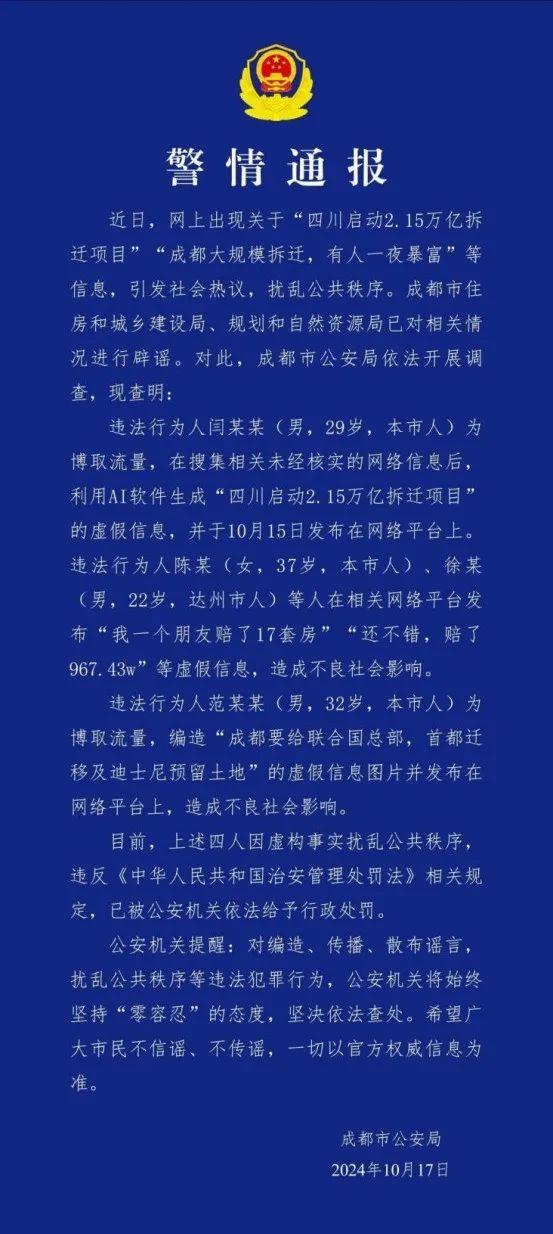"Chengdu large-scale demolition" online rumors reveal the risk of AI abuse
Author:Eve Cole
Update Time:2025-01-23 23:00:02
Recently, netizens in Sichuan whose IP address appears have concentrated on social media to “share” the demolition compensation they received: “received more than 9 million yuan”, “given 17 apartments, and three years’ rent,” etc. Overnight, the topic # ChengduLargescaleDemolition # went viral. #chengdudemolition# #成都综合外围上新# and other related topics have successively appeared on the hot search lists on various platforms.
Previously, staff from the Chengdu Municipal Housing and Urban-Rural Development Bureau had refuted the rumors, and reporters from Sichuan Observer had also visited the site to learn about the situation? Large-scale demolition in Chengdu? Has anyone received over 10 million in compensation? The official refutation of the rumors is here! “Large-scale demolition” and “huge compensation”? The reporter visited the demolition households on the spot: It’s nothing. On October 17, Chengdu police reported that “Sichuan launched a 2.15 trillion demolition project” was false information generated using AI software . The illegal perpetrator Yan Moumou and four other people were found guilty of fabricating the facts. Disturbing public order has been subject to administrative penalties by the public security organs in accordance with the law.
The Chengdu Public Security Bureau’s police report revealed the serious risks caused by the misuse of AI technology , which urgently require the attention and governance of all sectors of society. The most direct public opinion risk is that false information becomes more confusing, making it easier and faster to create and disseminate. In this case, the offender pieced together information about relevant topics posted online, used AI technology to generate "authoritative" text, and then False demolition compensation information was quickly and widely disseminated through social media platforms. In the current environment of efficient information dissemination, this phenomenon may seriously mislead the real situation, form the "truth" dissemination of false information, and bring wrong cognitive reactions to the public.
When the public is frequently exposed to false information, the trust of official information will be affected , especially when it comes to major public affairs such as government policies and social security. The proliferation of false information will cause people to question official information and change the cognitive structure of society. Create panic and misunderstanding. This erosion of credibility not only affects the effective dissemination of policies, but may also pose serious challenges to government credibility and social stability. The long-tail effect of public opinion may affect the market economic order. The widespread dissemination of false information may trigger irrational reactions in the market to a certain extent, leading to abnormal price fluctuations, thereby aggravating the imbalance between supply and demand in the market. Such unstable factors not only disrupt the market order, but may also trigger panic among investors, thereby triggering the risk of wider market disruption. In view of the misuse of AI technology and the public opinion risks it brings, all sectors of society must strengthen moral and legal supervision of AI technology.
In addition to establishing corresponding legal norms and policy frameworks to restrict and guide the rational application of AI technology, the following methods can also be tried at the public opinion response and disposal level: ① Guide social media platforms to strengthen information review and supervision mechanisms. Social media platforms should actively establish information Review mechanism to strengthen review and supervision of content. During the information release process, platforms should conduct preliminary screening of the authenticity of materials to reduce the spread of false information. At the same time, AI technology is used for content monitoring and identification to promptly detect and block false information. In addition, platforms should set up a complaint mechanism to encourage the public to report false information and enhance social governance capabilities.
② Advocate transparent and timely information release. The government and relevant agencies should actively adopt the principle of transparent and timely information release and form a relevant mechanism to regularly inform the public of true information. Especially in major events involving public interests, timely disclosure of official information can effectively combat the spread of rumors and strengthen public trust in official information. In addition to its own release channels and traditional mainstream media, the government can also use authoritative online media platforms and government self-media to enhance the timeliness and convenience of information release to meet the public's information needs. ③ Cultivate and improve the public’s media literacy. Facing the diversified background of information dissemination, it is particularly important to improve the public’s media literacy. Through education and publicity, we can improve people's ability to identify false information, enable them to analyze and judge the information they come into contact with more rationally, and reduce social chaos and panic caused by false information. It is recommended to carry out education on identifying the authenticity of online information at the grassroots level such as communities and streets, to help the public understand and master the methods of identifying information sources, verifying online rumors, and establish critical thinking about rumors.




